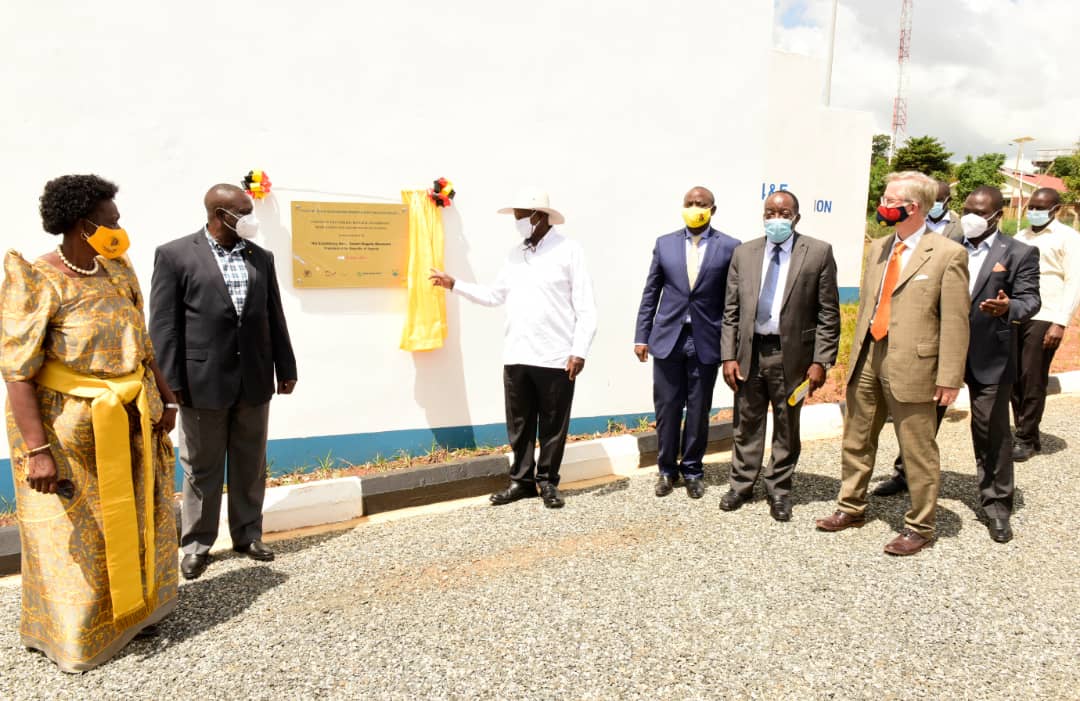
GULU — President Museveni has commissioned the newly refurbished Gulu Water Supply And Sanitation Project Phase 1.
He urged the people of Gulu to use the water to improve sanitation, health, the agriculture sector and economic transformation.
He cautioned Ugandans to stop invading and destroying lakes, rivers, forests and wetlands which, he said, are important water catchment points and “water factories.”
He stressed that the four natural features are not only important as sources of rain but they also help in the filtering of water to make it safer and easy to purify.
The 82 billion water plant will increase the daily water production capacity from 4,000,000 litres of water per day to 10,000 000 litres of water per day and serve over 200,000 people.
The refurbishment works were jointly funded by the World Bank, The German Corporation through Kfw and the Government of Uganda.
Museveni used the occasion to appeal strongly to Ugandans to jealously guard the environment against destruction bearing in mind that humanity cannot have enough and safe water when people are busy destroying the environment.
He commended the leadership of NWSC for their great vision that has resulted in the funding of most of the water works in the country using internally generated revenue.
He hailed Uganda’s development partners for their continued support to Uganda in a number of development programmes.
The Minister of State for the Environment Hon Beatrice Anywar who represented Water and Environment Minister, Mr. Sam Cheptoris, said that the Gulu water and sanitation project is in line with the National Development Plan, the sustainable Development Goals, and will improve the livelihoods of the people of Gulu.
She added that the sector is working to connect atleast one clean water source per village with 25shs per jerrycan, boost industrialization and connect clean safe water to all corners of Uganda.
“The recommended price of water at the NWSC pro-poor tariff is 50shs. Most water vendors are selling it 300shs and above. We are working to sensitize our people against this exploitation.” she shared
Minister of State for Water Ronald Kibuule urged Ugandans to harvest water.
“It is quite absurd that we wait for the water to run off our roofs and then fetch it from the water bodies.” he said
He added that the current demand for water in the city was 8million litres per day. The new plant will produce 10million litres per day to cater for the growing and future demands for services in the new city.” he said
The German Ambassador in Uganda Mathias Schauer commended the Ministry of Water and Environment and National Water and Sewerage Corporation for the tremendous efforts made towards providing safe clean water for all by 2030.
He highlighted the importance of safe water in limiting the spread of infectious diseases.
He appealed to the people of Uganda to mitigate the effects of climate change that are threatening adequate water supply.
“20 years ago Oyitino dam had enough water to keep all the taps in Gulu running. By 2012 the dam and all surrounding water resources could no longer maintain the supply for the people of Gulu. A costly process to transfer water from River Nile at Karuma to Gulu through a 72kms line is now being undertaken because wetlands have been encroached upon and forests cut down, reducing the water resource charge.
We are all responsible for conserving the environment for our children and grandchildren.” he advised
The National Water and Sewerage Corperation Board chairman, Eng. Dr. Prof Badru. M. Kiggundu Silver Mugisha, said that the Corporation is implementing a Five Year Strategic Direction and a Corporate Plan all anchored to the Sustainable Development Goals (SDGs), Uganda Vision 40 and the National Development Plan.
He shared some of the NWSC developments in the last 5 years which are not limited to;
•Growth in Geographical coverage, from 170 towns to now 258 towns.
•Water Network expansion from 9,900kms to 20,000kms (Average Annaul growth of 2000kms
•Grothh in customer base from 530,000 to 720,000 connections
•Total number of villages covered ( access to a public Tap with subsidized tariff) increased from 4,800 to 9,900 villages
•The Total population currently covered with safe water supply under NWSC jurisdiction is 15.7million
Some of the completed projects in the last 5 years include;
•Water and Sanitation projects in Arua, Bushenyi and now Gulu
•Nakivubo Waste Water Treatment plant, Nakivubo and Kinawataka Sewers Project and Kinawataka Pre-Treatment and Pumping Station
•Rehabilitation of Ggaba Water Work
•Kapchorwa Water Supply Project, Masindi Water Production Improvement Project, New Soroti Intake at Awoja, Upgrade of Kapeeka Water Supply Project, Fort Portal Water Production Improvements, Buloba Water Supply Project
•Packaged Sewage Treatment plants for Fort Portal and Kisoro
Among many more ongoing projects.
He reiterated the Corporation’s commitment towards water and Sanitation for all in all NWSC areas of operation.




